A very important element, for the beginners as well as for the pros, is positioning before the fight and the most common errors during the fight. Everybody can make those errors. As a consequence both pros and amateurs can sustain an unwelcome injury.
Remember, that a dangerous position during the fight can easily end a career.
There can be many errors to make, today we will focus only on the most common and important ones.
PHOTO DESCRIPTIONS
TYING THE STRAP
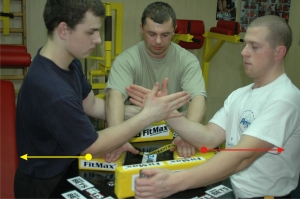
Before tying the strap, the contestants’ palms should be open, elbow placed on the outside of the pad.

Contestants’ thumbs should be open.

The main referee of the table holds the clasp of the strap with his right hand, with his left he wraps the strap around the right – side contestant’s hand.

Next the referee wraps the strap around the left – hand contestant.

The same is done for the right-hand contestant. In both cases the strap is wrapped at a maximum of 2cm below the wrist.

The procedure ends with the strap being wound from bottom to top.

And from top back to bottom.

By tightening the strap the contestants’ hand are being drawn together.

By a downwards movement the hands are drawn tight together.

The contestants are allowed to set up in a comfortable starting position.
THE MOST COMMON INJURY-RISK SITUATIONS

A very common injury comes from turning the head and body away from the fighting hand. Such movement can result in injury, and even in breaking the limb. That’s why the referee always asks the contestants to look at their fighting hands.

Sometimes during the fight a contestant will position themselves below the table line (shoulder of fighting hand below table line). Such form of combat, with a straight arm, is forbidden and punished by foul.

In this photo we can clearly see the straight arm position that can result in a serious shoulder injury.
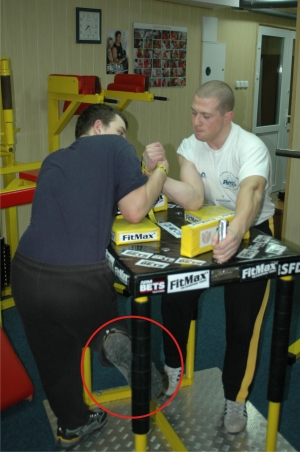
During combat, some contestants use their leg to support themselves against the table.

In this situation a foot can slip

The contestant can lose balance, resulting in failure and elbow / shoulder injury.

When using hook in straps, both an amateur and a pro can have insufficient strength in chest muscles.

This can cause an elbow to slip and hit the table top, resulting in elbow injury. That’s why it’s recommended to use only professional tables, both in training and in competitions.

One of the contestants has very strong back muscles.

This can cause their elbow to slip from the pad and the opponent’s elbow to slip also, which can result in both contestants’ elbows to get injured.
REAL LIFE EXAMPLES

Artur Głowiński’s shoulder is often below the table line, which causes him a foul.
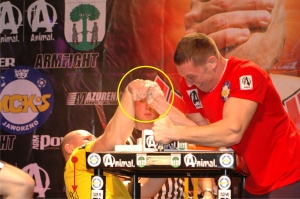
The left-side contestant’s shoulder is below the table line. His wrist is at a risk of injury.

During the “ready – GO!” command, the left-side opponent pulled the other opponent’s hand towards himself, causing a slip of elbow and a foul.

While counter-attacking, the right-side contestant knocks the other contestant’s elbow off the pad with a forward movement, which could cause injury.
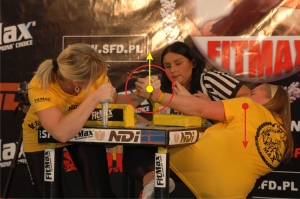
The right-side contestant has a straight arm (dangerous position). It’s all the more dangerous for fighting in straps – each sudden movement can cause injury on both sides.

Right-side opponent’s foul. His elbow is above the pad. In this case the referee should step in immediately, to avoid injury.

Left-side opponent’s foul (elbow off the pad), very risky for the other contestant. Immediate referee response is key here, to stop wrist injury.

Fighting with straight arm can cause injury on both sides.

The left-side contestant, fighting over the top, was too slow to attack and was stopped in an uncomfortable position. His elbow is close to foul. Any sudden movement can cause his elbow to slip and get injured.

Foul in winning position for the left-side opponent. Immediate referee intervention is key here, because the losing contestant’s arm is below the level of the side pad, and at risk of elbow / wrist injury.
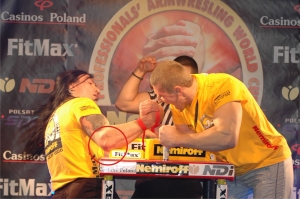
The contestant fighting over the top pulls towards himself, his elbow is close to foul. In this case the risk is increased for fighting in straps.

Mid-position foul of left-side opponent. A classic example of blocking the wrist by the right-side opponent. The right-side opponent blocks the other contestant’s hand from attacking over the top, by grabbing close to wrist.

